In other articles on this web site, I have described dives at my favourite shore dive site, Bare Island and the location I have dived most (as of November 2020, more than 575 times). In this article I will describe another dive that you can do at Bare Island. Located 20 kilometres from the centre of Sydney, Bare Island is part of Botany Bay National Park. From the city, travel along Anzac Parade or Bunnerong Road to La Perouse.
Upon arriving at La Perouse, park on the edge of Anzac Parade above the island as close to the island's access road as you can. Stand on the walkway overlooking the island to check the water conditions as well as the entry and exit points. This dive can be done in virtually all seas, even those from the south-east, although where you start and how you get to the reef will depend on the conditions. I have dived here many times when surfers have been surfing off the eastern end of the bridge that joins the island to the mainland. It is only in the hugest of seas that you cannot dive this site. One thing that can affect the site is that after prolonged periods of very heavy rain, the visibility can be reduced to one or two metres.
If you asked me back in the mid-1990s I would have said that even at its best, the visibility only got to four or five metres. However, since about 1999, visibility here has improved dramatically. The visibility has averaged almost 10 metres on these dives. It is certainly much better than the previous 13 years. Since the mid-2000s I have had a couple of 20 plus metre viz dives and on 7 May 2006 it was about 30 metres above 14 metres. The tides do not really have much impact on this dive although sometimes an outgoing tide can cause a current in the deep section of the dive. Visibility is sometimes better on high tide but I have also had good visibility at low tide.
The 15 Metre Reef, is, as you may imagine, at about 15 metres depth, although depending on the tide and where you are on the reef, it can vary between 14 and 16 metres. It is located off the western (right) side of the island and runs roughly west-north-west to east-south-east (so almost east-west). It is located about 15 metres off the main Bare Island Reef.
Do not dawdle in the deeper parts or you will run out of air.
 | 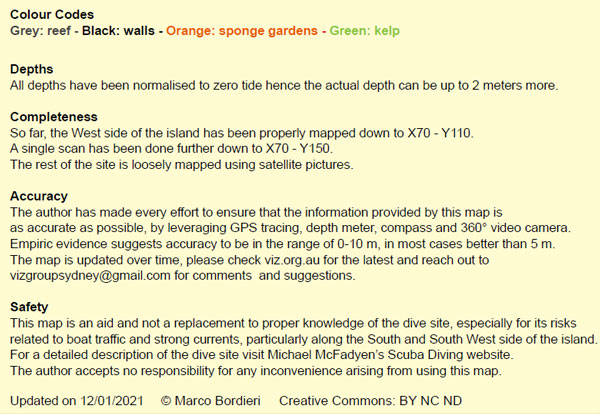 |
A new underwater map of Bare Island created by Marco Bordieri from www.viz.net.au.
For a much larger pdf version of this map, click here.
Used with permission of Marco Bordieri | Information about the map at left and below |
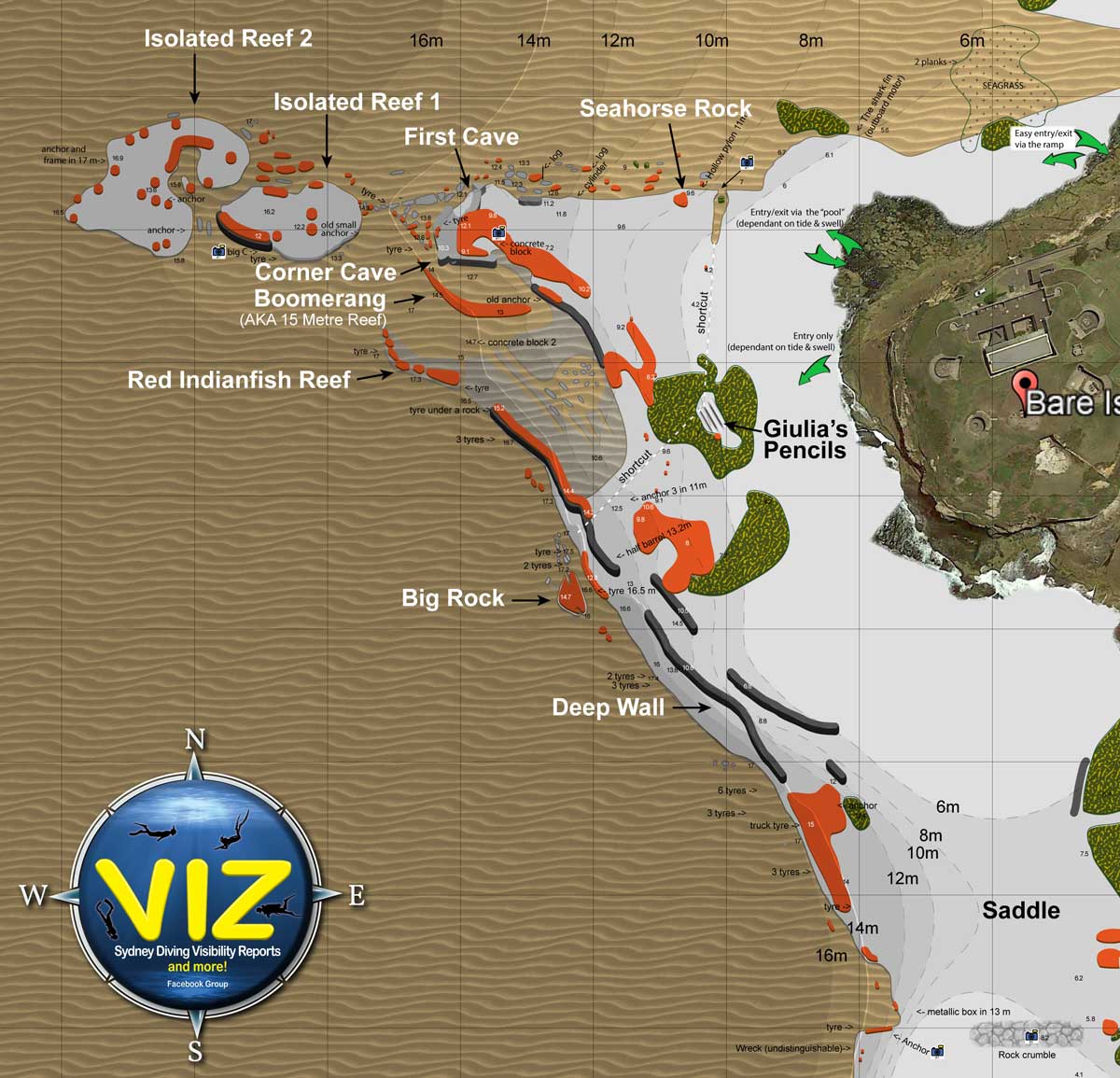 |
A new underwater map of the western side of Bare Island created by Marco Bordieri from www.viz.net.au.
For a much larger pdf version of this map, click here.
Used with permission of Marco Bordieri |
All these dives start on the island, walk across the bridge, then under the bridge and out along the rock platform. The exit point is normally the "boat ramp" which is right near the bridge. You can also exit along the platform till the Pool.
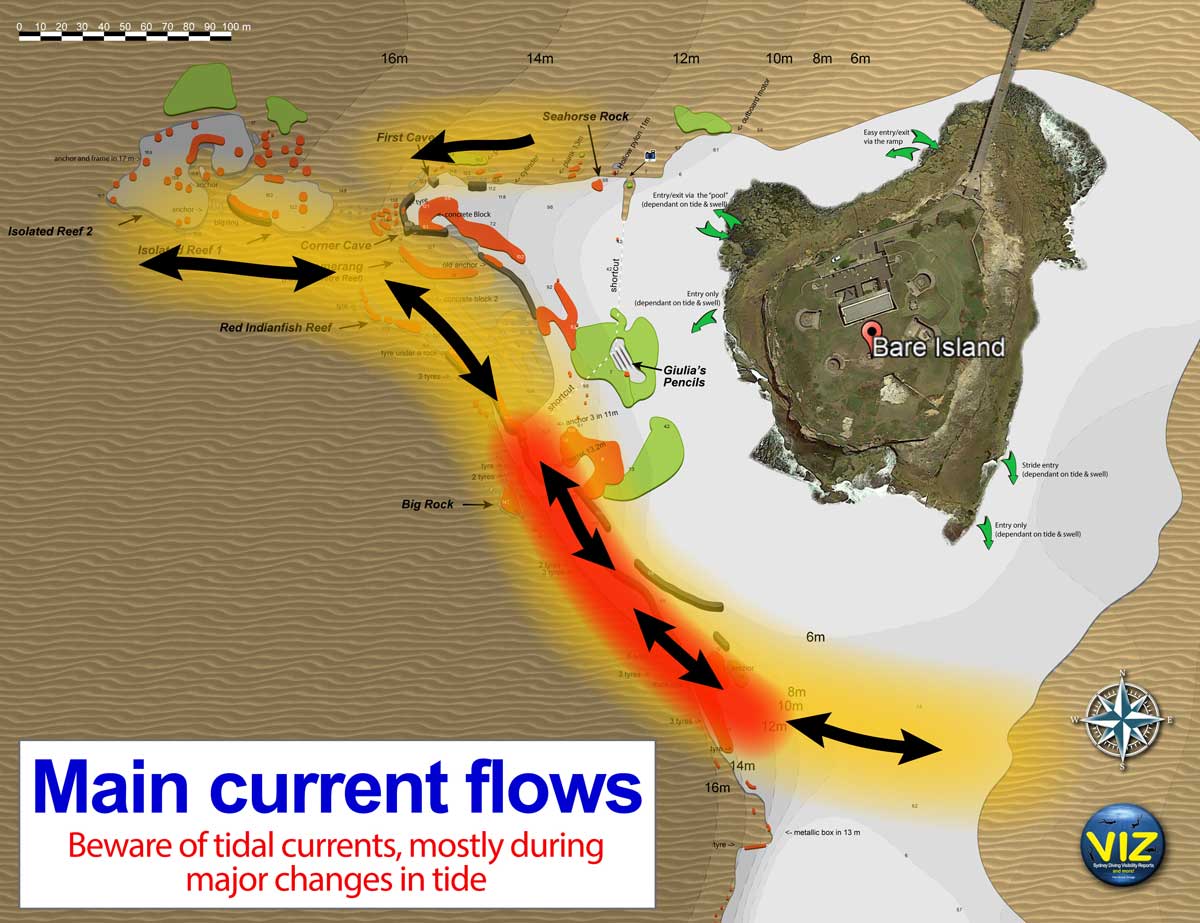 |
This shows the predominant tidal currents at Bare Island. Incoming are the currents to left, outgoing to right. Created by Marco Bordieri from www.viz.net.au using my information.
Used with permission of Marco Bordieri |
ENTRY POINT ONE - WESTERN POINT
DO NOT USE THIS ENTRY UNLESS YOU ARE SURE WHERE THE REEF ACTUALLY IS LOCATED
The preferred starting point is on the western point (the far right point as you look from the shore). You will need very flat seas to start here. If the tide is high and water is over the rock platform, you will need millpond seas. If the tide is lower, you can get away with a bit of very small swell.
Once at the point, put on your mask, gloves and fins (you will need to assess this yourself) and walk to the water's edge near the artificial channel that crosses the rock platform. Make sure you DO NOT do a giant stride when entering the water as it is very shallow here, even at high tide.
Once in the water, swim out about 15 to 20 metres before descending. This will put you in about 7 metres and at the starting point for the description of this dive. The other entry points end up here too. Jump to dive description below.
ENTRY POINT TWO - THE POOL
If it is too rough for the above entry spot, you may be able to start at the "Pool" which is the protected area just before the point. You will need relatively flat seas to start here. It is easiest when the tide is high. If the tide is low, you will have problems swimming out.
Once at the pool, enter the water and put on your mask, gloves and fins and surface swim out of the pool. Then swim on the surface around till you are off the western point. Make sure you are about 15 to 20 metres off the point before descending. This will put you in about 7 metres and at the starting point for the description of this dive. The other entry points end up here too. Jump to dive description below.
ENTRY POINT THREE - CAROL'S PLAQUE
If it is too rough for the above two entry spots, you will be able to start near the plaque to Carol Martin who died here on a night dive in 2010. If it is too rough to enter here, then you probably should not be diving Bare Island.
Once near the plaque, put on your mask and gloves an d carefully enter the water as it is very shallow. I normally put my fins on in the water. Swim out about 10 metres and descend. Once on the bottom, follow the sand edge to the "Shark's Fin" which is an aluminum sheet that looks like a fin. This is also where the remains of a large outboard motor are located, although as of 2020 little remains. This will take three minutes.
Turn left and cross over the rock bottom with the large boulders on your left. After about a minute you will come to sand again and then see an orange sponge on the sand. Continue following the reef edge and after another three minutes from the Shark's Fin you will come to another orange sponge at about 7 to 8 metres. This is the start of the Gully. This is sand at first but then a mixture of rock and sand bottom. You turn a little to the left here and go up the gully, getting shallower. They gully is fairly obvious, although in poor visibility it may be hard to follow.
Stay in the gully till you see some large boulders on your right. You will be in 4 to 5 metres. Go past these. It will be about two minutes from the last orange sponge to here. It then deepens and you will again be in about 7 metres and at the starting point for the description of this dive. The other entry points end up here too. Jump to dive description below.
If you go from near the Boat Ramp, add another 30 seconds to the first time in this section.
BARE ISLAND 15 METRE REEF DIVE
From the underwater starting point as per the above entry descriptions, head west. You will have a tumbledown reef wall on your right. Keep heading west and you will gradually get deeper. You will even see you are in a sort of gully At first the bottom is rocks and kelp but then you will have sponges. Continue on till you reach about 12 metres and the sand edge. It will have taken about 4.5 minutes to get here from the underwater starting point.
At this spot you can follow the sand/reef edge to the right and after about 5 or so minutes constant swimming you will come to Sea Horse Corner. However, this is not the preferred dive route. The best way is to first examine all the small and larger rocks near where you hit the sand. They are generally covered in sponges of all colours. Look carefully and you might see some pygmy pipehorses or big belly sea horses. There are normally lots of different species of nudibranch, I have seen over a dozen species here numerous times.
 | 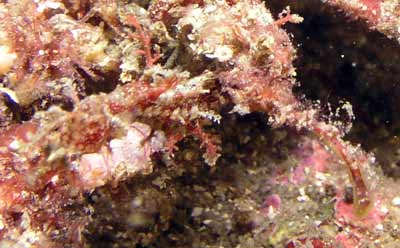 |
| A pygmy pipehorse on Sea Horse Rock | Can you see the same pygmy pipehorse?
Click on photo to see it |
If you are inexperienced you should then slowly follow the sand edge, gradually getting to about 14 metres. After 10 to 15 minutes, depending on how slow you go, you will come to a section where the sponges stop and the wall has virtually no growth on it. This the area near the south-eastern end of the 15 Metre Reef. From here, turn left and jump over to this reef, perhaps 10 metres at the most. At first it is very low and on the northern side it runs into the sand. There is a little drop of perhaps 0.25 to 0.5 metre on the southern side. Jump down a little to continue the description of the dive from here.
If you do not follow the sand edge as the above paragraph, you can go as follows. After examining the rocks and boulders, swim to the west or north-west and zig-zag from rock to rock and patches of sponges on the sand. The depth will gradually increase to about 15 metres and even 16 metres and you will be heading north-west. My preferred way is to mostly be on sand, but, sometimes I might go a bit more south-west and follow the top of the Deep Wall reef (see Deep Wall dive). Along here we see lots of Port Jackson sharks in spring.
If you keep deeper, you may reach Red Indianfish Reef (RIF Reef) which is the reef located on your left as you come up from the Deep Wall dive. If you reach RIF Reef, you can have a quick look on the edge. As you can tell from the name, we nearly always see red indianfish here. If you are not so deep, you may come to the large Deep Concrete Block which is to the north-east of RIF Reef. From the block, head due north and you will hit 15 Metre Reef near the same point as mentioned two paragraphs above. If you go even shallower, you will also end up at the same point.
The whole of 15 Metre Reef is composed of sponges, ascidians, small gorgonians, sea squirts, sea whips and much more. On the weed in between all this you can see lots of species of nudibranch as well as very often pygmy pipehorses. On the sponges etc, there are more species of nudibranch, including some rarer species that are hard to find. Continue swimming along the reef.
If you are good with your air, you will need at least 100 bar to get back from the end of the reef if you continue to swim at a slow, examining pace.
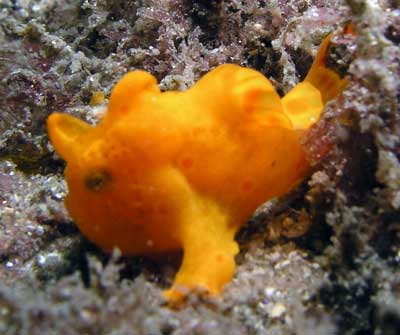 |  |
The tiny yellow anglerfish
Note very poor photo - slightly blurry | A red Indianfish at Bare Island |
On the southern side there is a very small drop to the sand and in spots there are some very low overhangs. Check these out as there are often (always) pipefish living in them. There are also shrimp and sometimes in the larger one, a blue devilfish. Also on top of the reef are red indianfish, normally at least one is seen. You may also see Port Jackson sharks here. We also see firefish (lionfish), mostly dwarf ones, all year round.
Once you hit the end of the reef, turn right. This is north. If the visibility is pretty good, you should be able to see the main Bare Island reef or at least the shadow of it. When you get over there you will see you are at Sea Horse Corner. From here you follow the normal Bare Island Right dive back to the island.
We called this Sea Horse Corner as for about six years from 2004 there could be up to five big belly sea horses living under the low overhang or less often on the top of the overhang. However, since about 2010 we have seen none.
 | 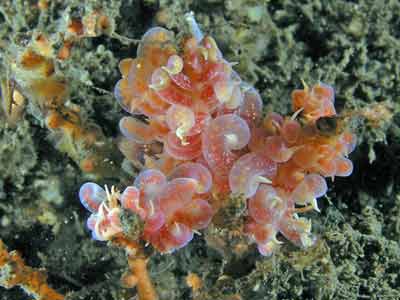 |
This is the yellow Whites sea horse
seen from 26 January till 3 July 2011 | A couple of made-up phyllodesmium nudibranchs
aka opera house nudis |
You can either follow the main wall (which is shorter) or go around the larger boulders to the northern side of the reef and follow the sand edge back. This is the normal way. You can go along the sand edge for perhaps 10 metres and then go across the reef. You may see pygmy pipehorses and sea horses in this area, I have even seen Bare Island anglerfish and painted anglerfish as well as red Indianfish. You will then end up back on sand, follow this edge to your right (east). You will come to the Cave (in poor visibility it may not be seen).
If you follow the wall, you will see a few overhangs and inlets and also that you go between the wall and some very large boulders. Right at the start here there is the Shallow Concrete Block. This was put here for an unknown reason when Energy Australia installed a submarine electricity cable from Larpa Point to Kurnell in about 2008. Go a bit further along and you will see a crack with some sea tulips above. From about 11 July 2004 for 18 months we used to see big belly sea horses here, up to at least six separate sea horses
 | 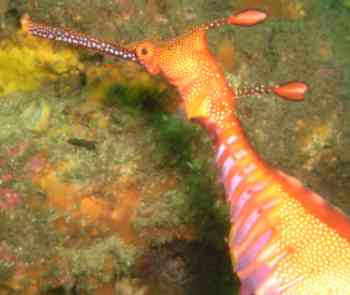 |
| A Whites sea horse I saw on 26 January 2008 | A close up of a common sea dragon |
Inside the Cave you will find heaps of colourful marine growths including gorgonias. A resident blue groper can often be found in the cave as well as the usual cave dwellers like estuary catfish, Sydney cardinalfish, yellow banded sea perch and half-banded sea perch. Outside the cave on the rocks there are sponges of all colours as well as giant ascidians, lace coral and Bairds solitary coral. You will have noticed these for the past 50 metres or so.
About 10 metres on there is a low but deep overhang. This is home to lots of fishlife, and in August is normally full of Port Jackson sharks. You may also see some eastern blue devilfish under the low overhangs. The depth is about 14 to 15 metres.
 |
A panoramic photo of the cave area on the right side of Bare Island
Taken 7 May 2006 with 30 metre visibility |
We also regularly see sawtooth pipefish under the very small overhangs on the sand. From here you can continue along the wall or again head out to the north a bit around a bunch of boulders and rocks. All along this area you may see red Indianfish, pygmy pipehorses and many species of nudibranchs. We also regulalry see small painted anglerfish and sometimes Bare Island anglerfish.
In this are I found a grey nurse shark on a dive on 18 April 2007. The shark was a small female, a bit over 1.5 metres long. She came in while I was taking photos of a small sea dragon and swam over to the wall, went up the top and to the west. She then came back to the bottom and went back east and then up over the reef top and disappeared to the south. This was the first grey nurse shark I had seen at Bare Island but I have seen them near here again and on the southern side of Botany Bay at Inscription Point and nearby.
 | 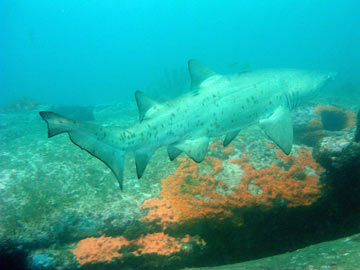 |
| A Grey nurse shark that I saw in the 13 metre area of Bare Island Right on 18 April 2007 |
From here the dive goes over or around some large boulders and then you will come to Sea Horse Rock. This is about 12 metres and has a large cylinder-like timber piece about 1.5 metres long and 750 mm high located on the eastern side. This timber piece is an old section of the Bare Island Bridge.
For the period from 2003 there used to be three big belly sea horses on the sponges on this rock, hence its name. They were mostly on the western side of the rock. I first saw one of them in March 2003 and found the others soon after. The See the table below for details of sightings as well as some photographs. There were there for about three years till early 2006.
Sea horses seen right side of Bare Island - On Sea Horse Rock at 12 metres
Blank indicates not seen
| Date | Sea horse A - Male | Sea horse B | Sea horse C | Comments |
| 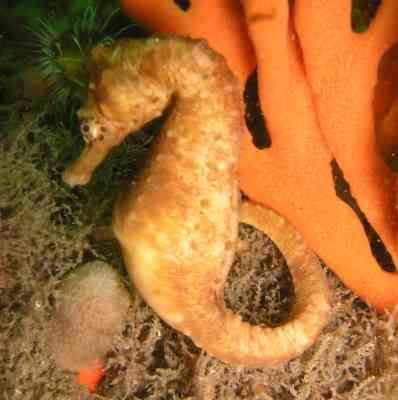 |  |  | |
| Normally under grey sponge on
south but since 18/3/04 on B's sponge as in above photo
Click above photo to enlarge | Normally near orange sponge at north but early 2004 on sand to south between rocks and May 2004 E of sponge | Normally on side of rock SW corner | |
| 29 Mar 2003 | | Seen | | |
| 28 Apr 2003 | | Seen | | |
| 31 Aug 2003 | Yellow
See photo | Seen | | |
| 24 Sep 2003 | Yellow | Yellow
See photo | | |
| 8 Oct 2003 | Pale yellow | Very bright yellow
See photo | | |
| 10 Oct 2003 | Not seen | Very bright yellow and appears pregnant | | |
| 12 Nov 2003 | Pale yellow but pregnant | Not seen | | |
| 13 Dec 2003 | Pale brown | Yellow with red tinge | | |
| 26 Dec 2003 | Pale brown | Not seen | Pale grey and pregnant
See photo | |
| 2 Jan 2004 | Pale brown | Pale yellow with red tinge | Pale grey and not pregnant | |
| 4 Jan 2004 | Pale brown | Pale yellow with red tinge | Pale grey | |
| 15 Feb 2004 | Pale brown and skinny | Pale yellow with red tinge and very skinny | Pale grey and a bit gaunt | |
| 28 Feb 2004 | Pale yellow, skinny more prominent spots | Not seen | Pale grey and a bit gaunt | |
| 6 Mar 2004 | Pale yellow, skinny more prominent spots | Pale yellow and very skinny | Pale grey and a bit gaunt | |
| 18 Mar 2004 | Pale yellow, skinny more prominent spots | Pale yellow and very skinny | Pale grey and a bit gaunt | |
| 6 Apr 2004 | Pale brown, skinny more prominent spots | Pale yellow and very skinny | Pinky colour and very thin | |
| 18 Apr 2004 | Pale yellow, skinny more prominent spots | Not seen | Very red colour and very thin | |
| 16 May 2004 | Pale brown, skinny more prominent spots | Yellow with pink tinge and less skinny | Very red colour and a bit gaunt | |
| 27 June 2004 | Pale brown, skinny more prominent spots | Yellow with pink tinge and skinny | Dark brown and quite skinny | |
| 2 July 2004 | Pale brown, skinny more prominent spots | Yellow with pink tinge and skinny | Dark brown but more prominent belly | |
| 11 July 2004 | Pale brown, skinny more prominent spots | Yellow with pink tinge and very skinny | Brown/red and very prominent spots | |
| 12 Aug 2004 | Pale brown, skinny more prominent spots | Yellow and very skinny | Brown/red and very prominent spots | |
| 26 Aug 2004 | Pale brown, very skinny and more prominent spots | Yellow and very skinny | Brown/red, skinny and very prominent spots | |
| 17 Oct 2004 | Pale brown and not as skinny | Yellow with pink tinge | Brown/red and not as skinny | |
| 18 Nov 2004 | Pale brown and not as skinny | Yellow with pink tinge, thicker | Brown/red and not as skinny | |
| 23 Dec 2004 | Pale brown and skinny | Yellow with pink tinge, thinner | Brown/red and skinny | |
| 3 Feb 2005 | Skinny | Yellow with purple edge, big belly | Bown/red sand skinny | |
| 20 Feb 2005 | Pale brown, skinny but very prominent belly | Yellow with a bit of purple, skinny | Brown/red and skinny | |
| 20 Feb 2005 |  | 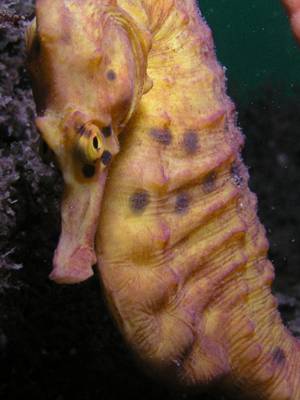 | 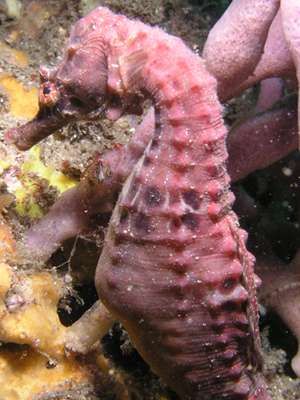 | |
| 27 Feb 2005 | Pale brown, skinny but very prominent belly | Yellow with a bit of purple, skinny | Brown/red and skinny | |
| 5 Mar 2005 | Pale brown, skinny and belly gone | As above - was on sand to SW of rock | Brown/red and bigger belly | |
| 24 Apr 2005 | Pale brown, skinny and belly white | Yellow | Brown/red and bigger belly | |
| 2 Jun 2005 | Pale brown, skinny and belly white | Yellow but not on normal rock - 5 m to west | Very red | |
| 9 Jul 2005 | Pale brown and skinny | Dirty yellow | Very red and dirty looking | |
| 28 Aug 2005 | Not seen | Bright yellow and large belly | Not seen | |
| 6 Oct 2005 | Not seen | Yellow and skinny and mauve on tail | Skinny and very pink | |
| 8 Oct 2005 | Not seen - May be dead? | Yellow and skinny and mauve on tail | Skinny and very pink | |
| 3 Nov 2005 | Assumed dead | 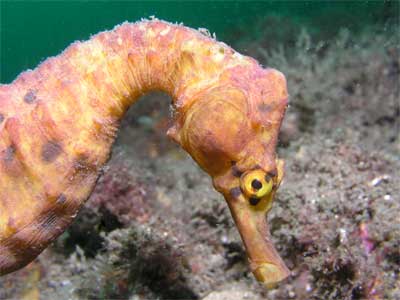 | Skinny and very dark mauve | |
| 4 Nov 2005 | Assumed dead | Yellow with pink tinge | Skinny and very dark mauve | |
| 8 Dec 2005 | Assumed dead | Yellow with pink tinge | Skinny and very dark mauve | |
| 23, 25 and 26 Dec 2005 | Assumed dead | Yellow with pink tinge | Skinny and very dark mauve | |
| 2 Jan 2006 | Assumed dead | Yellow with pink tinge | Very dark mauve | |
| 11 Jan 2006 | Assumed dead | Not seen | Not seen | |
| 22 Jan 2006 | Assumed dead | Not seen | Skinny and very dark mauve | |
| 27 Jan 2006 | Assumed dead | Assumed dead | Skinny and very dark mauve | |
| 28 Jan 2006 | Assumed dead | Assumed dead | not seen | |
| 29 Jan 2006 | Assumed dead | Assumed dead | Skinny and very dark mauve | |
2 and 23 Feb 2006
5 Mar 2006 | Assumed dead | Assumed dead | Assumed dead | |
However, in January 2006 the last of the sea horses was seen. They are now all assumed to be dead. Since then there are regularly upsidedown pipefish and tiger pipefish under the very small overhang on the northern side and in 2020 there was a tiny pineapplefish under the western side.
From here follow the sand edge and you will go past some rocks and then more sand and then more rocks, these ones have lots of sea tulips and a couple kelp on top. We regularly see sea horses on these rocks. The reef turns to the south-east for a bit. You will see an orange/yellow sponge after about 60 seconds, turn left and then you will see another one after another 60 seconds. This is one you may have seen at the start of the dive.
You will then cross a low reef, with clean boulders on your right and after another minute come to the Shark Fin (5-6 metres). Follow the sand edge back. After about three minutes you will come to some kelp and weed. Cross this and then turn left and follow the sand adjacent to the small reef edge (about 3 metres deep) till you see some small rocks on the sand. These were put there by me back in about 2000 to indicate to turn right. Go up and over the reef and you will be at the Boat Ramp.
This is an excellent dive, well worth doing time after time. Visibility can vary from 20 metres down to 3 metres. Average in more recent years would be more like 7 to 10 metres.
Once you are more experienced, try out the deeper dives on the right side of Bare Island. There are two, the Isolated Reefs and the Deep Wall. A list of commonly seen (and rarer) fish, sea dragon sightings and warnings are on the Bare Island Right page.

 v6.00.307 © 2003-2005
v6.00.307 © 2003-2005